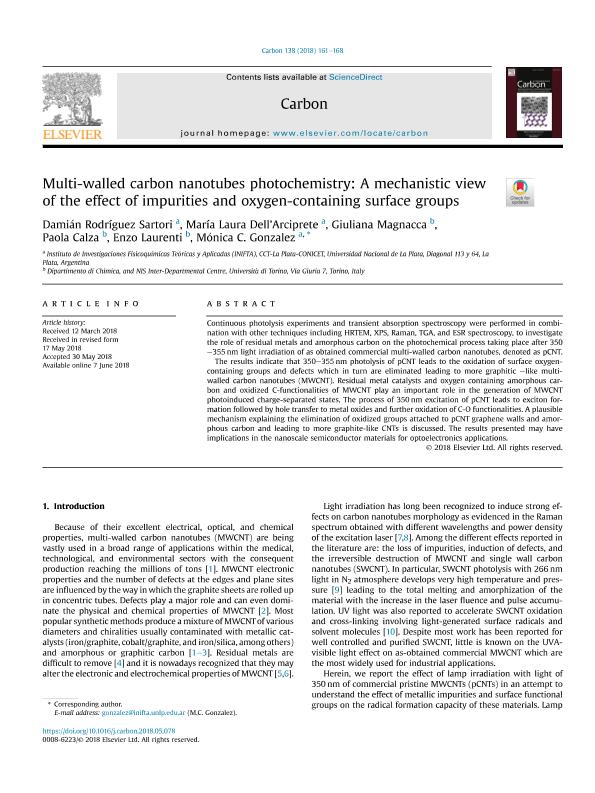Mostrar el registro sencillo del ítem
dc.contributor.author
Rodriguez, Damian

dc.contributor.author
Dell'arciprete, Maria Laura

dc.contributor.author
Magnacca, Giuliana
dc.contributor.author
Calza, Paola
dc.contributor.author
Laurenti, Enzo
dc.contributor.author
Gonzalez, Mónica C.
dc.date.available
2020-03-18T19:11:44Z
dc.date.issued
2018-11
dc.identifier.citation
Rodriguez, Damian; Dell'arciprete, Maria Laura; Magnacca, Giuliana; Calza, Paola; Laurenti, Enzo; et al.; Multi-walled carbon nanotubes photochemistry: A mechanistic view of the effect of impurities and oxygen-containing surface groups; Pergamon-Elsevier Science Ltd; Carbon; 138; 11-2018; 161-168
dc.identifier.issn
0008-6223
dc.identifier.uri
http://hdl.handle.net/11336/100098
dc.description.abstract
Continuous photolysis experiments and transient absorption spectroscopy were performed in combination with other techniques including HRTEM, XPS, Raman, TGA, and ESR spectroscopy, to investigate the role of residual metals and amorphous carbon on the photochemical process taking place after 350–355 nm light irradiation of as obtained commercial multi-walled carbon nanotubes, denoted as pCNT. The results indicate that 350–355 nm photolysis of pCNT leads to the oxidation of surface oxygen-containing groups and defects which in turn are eliminated leading to more graphitic –like multi-walled carbon nanotubes (MWCNT). Residual metal catalysts and oxygen containing amorphous carbon and oxidized C-functionalities of MWCNT play an important role in the generation of MWCNT photoinduced charge-separated states. The process of 350 nm excitation of pCNT leads to exciton formation followed by hole transfer to metal oxides and further oxidation of C-O functionalities. A plausible mechanism explaining the elimination of oxidized groups attached to pCNT graphene walls and amorphous carbon and leading to more graphite-like CNTs is discussed. The results presented may have implications in the nanoscale semiconductor materials for optoelectronics applications.
dc.format
application/pdf
dc.language.iso
eng
dc.publisher
Pergamon-Elsevier Science Ltd

dc.rights
info:eu-repo/semantics/openAccess
dc.rights.uri
https://creativecommons.org/licenses/by-nc-sa/2.5/ar/
dc.subject
CARBON NANOTUBES
dc.subject
PHOTOCHEMISTRY
dc.subject
IMPURITIES
dc.subject.classification
Físico-Química, Ciencia de los Polímeros, Electroquímica

dc.subject.classification
Ciencias Químicas

dc.subject.classification
CIENCIAS NATURALES Y EXACTAS

dc.title
Multi-walled carbon nanotubes photochemistry: A mechanistic view of the effect of impurities and oxygen-containing surface groups
dc.type
info:eu-repo/semantics/article
dc.type
info:ar-repo/semantics/artículo
dc.type
info:eu-repo/semantics/publishedVersion
dc.date.updated
2020-03-16T13:59:23Z
dc.journal.volume
138
dc.journal.pagination
161-168
dc.journal.pais
Estados Unidos

dc.description.fil
Fil: Rodriguez, Damian. Consejo Nacional de Investigaciones Científicas y Técnicas. Centro Científico Tecnológico Conicet - La Plata. Instituto de Investigaciones Fisicoquímicas Teóricas y Aplicadas. Universidad Nacional de La Plata. Facultad de Ciencias Exactas. Instituto de Investigaciones Fisicoquímicas Teóricas y Aplicadas; Argentina
dc.description.fil
Fil: Dell'arciprete, Maria Laura. Consejo Nacional de Investigaciones Científicas y Técnicas. Centro Científico Tecnológico Conicet - La Plata. Instituto de Investigaciones Fisicoquímicas Teóricas y Aplicadas. Universidad Nacional de La Plata. Facultad de Ciencias Exactas. Instituto de Investigaciones Fisicoquímicas Teóricas y Aplicadas; Argentina
dc.description.fil
Fil: Magnacca, Giuliana. Università di Torino; Italia
dc.description.fil
Fil: Calza, Paola. Università di Torino; Italia
dc.description.fil
Fil: Laurenti, Enzo. Università di Torino; Italia
dc.description.fil
Fil: Gonzalez, Mónica C.. Consejo Nacional de Investigaciones Científicas y Técnicas. Centro Científico Tecnológico Conicet - La Plata. Instituto de Investigaciones Fisicoquímicas Teóricas y Aplicadas. Universidad Nacional de La Plata. Facultad de Ciencias Exactas. Instituto de Investigaciones Fisicoquímicas Teóricas y Aplicadas; Argentina
dc.journal.title
Carbon

dc.relation.alternativeid
info:eu-repo/semantics/altIdentifier/url/https://www.sciencedirect.com/science/article/abs/pii/S0008622318305578
dc.relation.alternativeid
info:eu-repo/semantics/altIdentifier/doi/http://dx.doi.org/10.1016/j.carbon.2018.05.078
Archivos asociados
